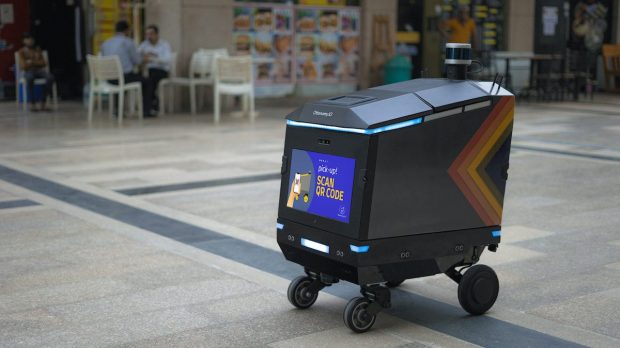Restaurants Turn to Robotics to Fulfill Delivery Demand

As restaurants struggle to meet consumers’ desire for on-demand delivery in the face of labor challenges, robotic solutions are gaining traction.
Technology startup Ottonomy.IO announced Tuesday (April 26) plans to expand the use of its autonomous delivery robots internationally, with the company beginning pilot tests in airports in Rome and Pittsburgh and with plans to roll out additional trials in North America, Europe and the Middle East throughout the rest of the year.
“Ottobots have been in pilots with retailers and restaurants across North America. Our multiple trials have highlighted that the robots can safely navigate in crowded and populated indoor environments and outdoors on varying terrains and weather conditions,” Ottonomy.io CEO and Co-Founder Ritukar Vijay said in a statement.
Additionally, earlier this month, it was reported that Brinker International, parent company of Chili’s Grill and Bar and Maggiano’s Little Italy in addition to two virtual brands, is trying out autonomous delivery via Serve Robotics’ sidewalk delivery rovers. The news came after, at the end of March, the company announced the expansion of its drone delivery test to Texas.
Read more: Chili’s Parent Trials Sidewalk Delivery Robots
In an interview earlier this month with PYMNTS, Brinker International Senior Vice President and Head of Innovation Wade Allen said drone delivery can help meet consumers’ rising demand for digital convenience.
“Delivery is really inefficient,” Allen said. “It’s a half-ton vehicle. It’s a single person generally taking food somewhere between a mile to two miles. Gas prices are going up. There’s pressure on labor or there’s just a lot of expense in that. It’s really inefficient. So, you start to think about, ‘Hey, is there a smarter way to do this?’ And drones are one way in particular that … could solve a problem … and take a lot of cost out of that structure.”
See more: Chili Parent Brinker International Says Automation Is the ‘Heartbeat’ of Innovation
A sizable share of consumers order delivery on a regular basis. Research from PYMNTS’ March/April study “The Digital Divide: Regional Variations in U.S. Food Ordering Trends and Digital Adoption,” created in collaboration with Paytronix, found that about one in three had ordered from a restaurant aggregator such as DoorDash or Uber Eats in the previous 30 days.
Read more: New Research Shows That Regional Dining Quirks Matter in Tailoring Restaurant Offers
Moreover, restaurants that can meet consumers’ demand for delivery outperform their non-delivering counterparts. Research from PYMNTS’ 2022 Restaurant Friction Index, also created in collaboration with Paytronix, found that 97% of top- and middle-performing restaurants offer delivery, while only two-thirds of bottom performers do the same.
See more: Loyalty Programs Best Way to Get Diners to Spend More
Last month, robotics company Starship announced the launch of its autonomous food delivery service at The University of Tennessee, Knoxville, and ghost kitchen company Reef Technology announced a partnership with robotics startup Cartken to launch robotic delivery in Miami.
“Delivery continues to be the driving force behind supporting many of our beloved restaurants while staying safe during this pandemic. However, the rising demand for delivery has created a bottleneck during peak dining hours that slows efficiency,” said Reef Chief Technology Officer Matt Lindenberger in a statement. “We’re looking at our robot delivery service as a long-term solution that can advance the delivery ecosystem by offering speed, quality and scale while reducing congestion and carbon emission.”
